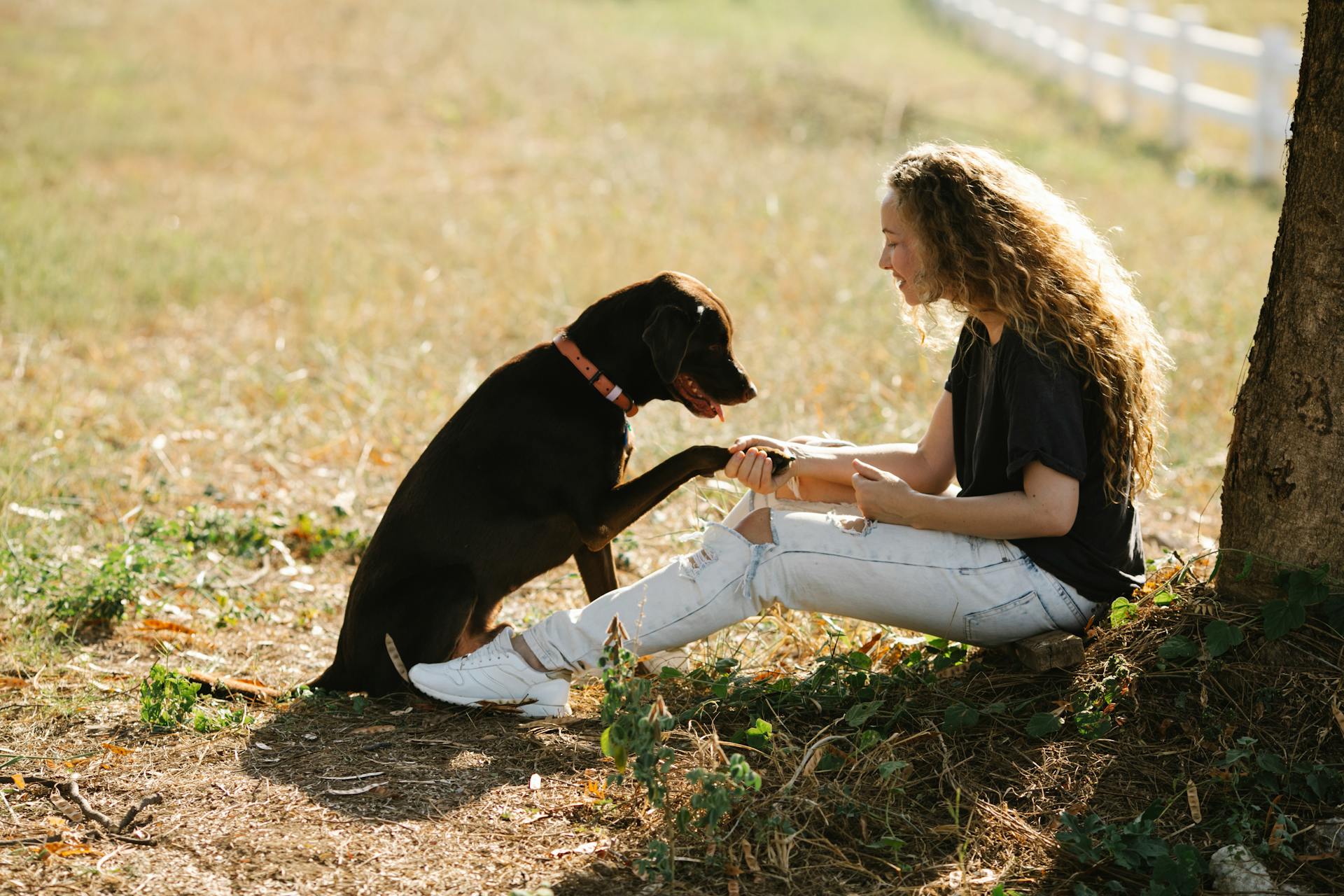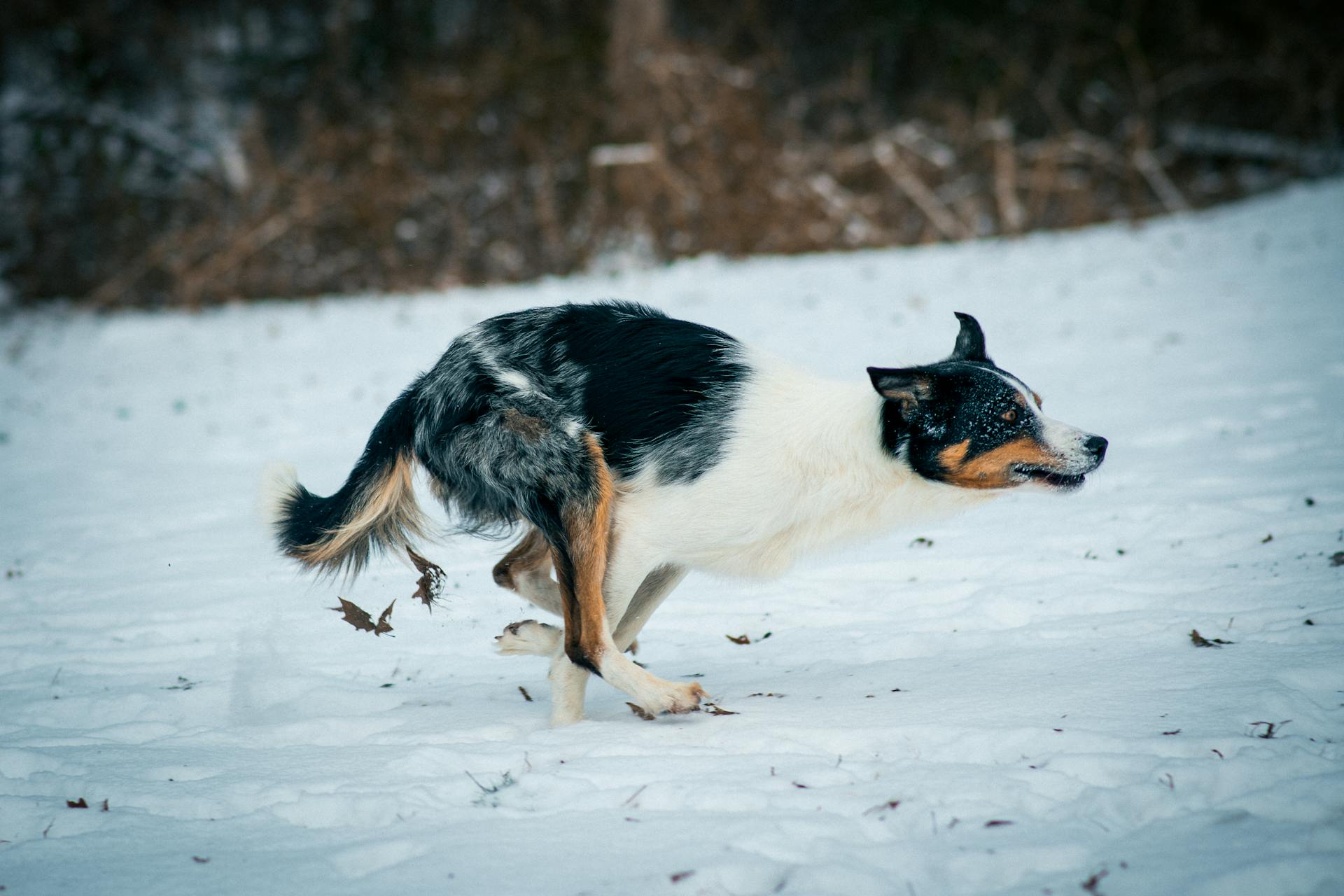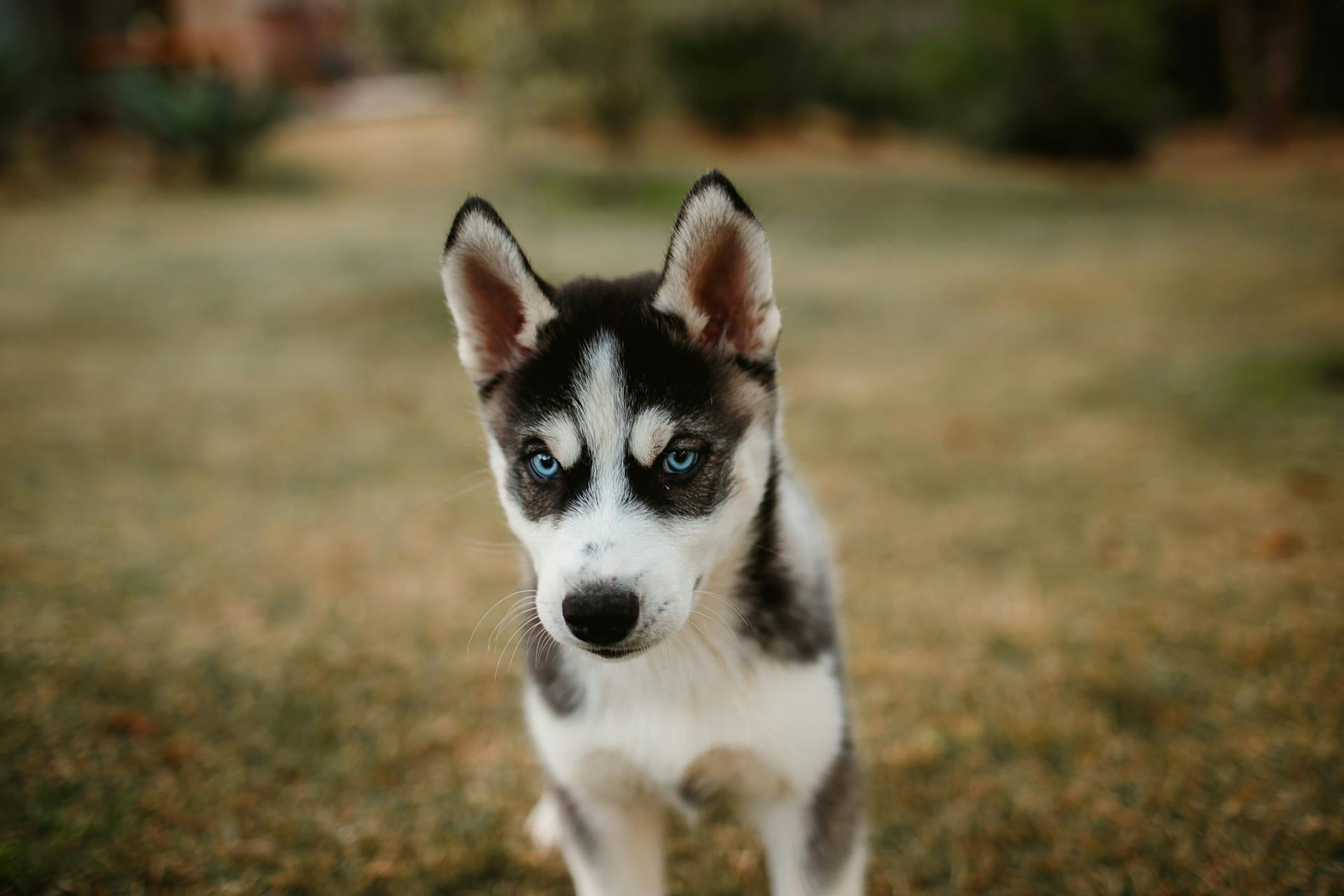
Potty training a puppy can be a daunting task, but with the right approach, you can teach your furry friend to go potty outside in no time. Establish a routine, take your puppy outside frequently, and reward good behavior.
Consistency is key when it comes to potty training. Take your puppy outside to the same spot each time, and use a consistent command like "go potty." This will help your puppy learn to associate the command with the action.
Puppies have small bladders and can't hold their urine for long periods, so take them outside frequently, especially after meals and playtime. Puppies can hold their urine for about 1-2 hours, depending on their age and size.
Praise and reward your puppy for good behavior. Use treats and praise to reinforce good habits, and be patient with accidents.
Recommended read: Aggressive Behavior in Puppies Training
How to Use a Crate
Using a crate is a crucial part of potty training your puppy. It helps keep them safe and prevents accidents.
A crate should be just large enough for your dog to lie down, stand up, and turn around. This size will help them feel secure and less likely to use one corner for elimination.
Dogs are den animals and will seek out a cozy space for security. Providing a crate can make it easier to train them to love their new den.
If you let your dog have an accident in the crate, they'll think it's okay to mess up their living space. This can lead to more accidents and make potty training harder.
Here's a simple schedule to help you keep your puppy on track:
- 7am Wake up – Go outside to go potty
- 7:15am playtime
- 7:30 breakfast
- 8:00 outside for potty break
- 8:15 playtime
- 9:00 crate time
- 10:00 out of crate – potty break
- 10:15 training
- 10:30 outside then X pen time
- 11:30 playtime
- 12:00 Feeding. Repeat schedule
Housebreaking Techniques
You can potty train a puppy in various ways, including using dog training pads or crate training. These methods offer unique benefits during all stages of the training process.
To use training pads effectively, choose pads that accommodate your dog's size and allow your puppy sufficient time to get familiar with the pad before they need to use it. Guide your pet gently toward the pad and encourage them to eliminate.
Crate training is another great way to approach potty training, as dogs will rarely "go" in the same place they sleep. You can gradually allow your puppy more freedom, 15-20 minutes after they went potty outside.
To crate train effectively, keep a schedule that includes regular potty breaks and crate time. Here's a sample schedule:
Remember, consistency is key when it comes to potty training. With patience and persistence, you can help your puppy learn to go potty outside where they belong.
Pick a Method
Choosing the right method for housebreaking your puppy can be overwhelming, but it's essential to pick one that suits your furry friend's needs and your preferences. You can choose between using dog training pads or crate training.
Dog training pads are a great option, especially if you have a small living space or a puppy that's not yet familiar with going outside. Choose pads that accommodate your dog's size and allow them sufficient time to get familiar with the pad before they need to use it. This will help your puppy learn to associate the pad with going potty.
Crate training is another effective method, as dogs tend to avoid soiling their sleeping area. After taking your puppy for an evening potty break, lead them to the crate for the night, and after they wake up, head straight to the potty spot for morning relief. This will help your puppy learn to hold their bladder and bowels until they're taken outside.
Some puppies might be resistant to crate training at first, but with consistency and patience, they'll eventually recognize it as a secure space.
Make a Routine
Establishing a routine is key to successful housebreaking. Consistency is crucial, so create a schedule that works for you and your dog.
Feed your dog at the same times every day to help them learn when it's time to go outside. A consistent feeding schedule also helps prevent accidents.
Take your dog outside immediately after meals to prevent accidents. According to the article, taking them outside every hour or two is also a good idea, especially for young puppies.
You might enjoy: Crate Training Puppies Schedule
Create a "potty zone" in your yard by designating a specific area for your dog to do their business. This will help them learn to go in one spot and make cleanup easier.
Take your dog to the "potty zone" at the same times every day, such as after meals and naps. This will help them learn to associate these times with going outside.
Avoid giving treats or praise for accidents, as this can create confusion and make housebreaking more difficult. Instead, reward your dog with treats and praise when they go in the "potty zone".
Using Paper
Using paper training can be a bit tricky, as it reinforces two different options for the puppy. This can confuse them and make it harder to learn to go potty outside.
Puppy pads are a popular option for indoor potty training, giving dogs a designated spot to relieve themselves at home. They can be especially helpful for people with jobs that make it difficult to get home multiple times a day.
Curious to learn more? Check out: At Home Obedience Training for Puppies
Some owners also use indoor dog bathrooms, which work for male dogs as well as females. These can be a convenient and practical solution for tiny dogs living in areas with harsh winters.
After the dog matures, owners can work on transitioning them to going potty outside all the time.
Broaden your view: Prairie Dogs
Monitoring Progress
Puppies can hold their bladder for how many months they are + 1, so a 3 month old puppy can usually hold it for around 4 hours.
Tracking your puppy's potty schedule is key to understanding their patterns. Note every time you take your puppy out to go to the bathroom, if they went, and any accidents in the house.
Keep track of your puppy's potty habits by creating a house training chart or using a notepad to take notes. This information will help you learn their patterns and adjust your schedule accordingly.
As your puppy gets older, you can give them more time between potty breaks. After 6 months of age, puppies can generally hold it 6-8 hours.
Related reading: Dog Potty Training Schedule
Some common times for puppies to need to go to the bathroom include:
- After eating
- After drinking
- After five to 10 minutes of play or other vigorous activity
- Immediately after waking up from a nap
In the beginning, it's not uncommon for puppies to wake up in the middle of the night for a few nights before falling into a routine.
Dealing with Accidents
Accidents are inevitable, but with the right approach, you can minimize them and set your puppy on the path to successful potty training.
The key is to catch your puppy in the act and quickly pick them up while they're still going, rushing them outside to finish. This helps prevent accidents from happening in the first place. If you miss the accident, cleaning it up properly is essential to prevent your puppy from returning to the same spot.
You need to use an enzyme cleaner to break down the urine and eliminate the smell, which can attract your puppy to the same spot again. Don't rely on other cleaners that might mask the smell, as your puppy can still detect it.
To prevent future accidents, make sure to clean the area thoroughly, soaking it with the enzyme cleaner and letting it sit for at least 5 minutes before removing the excess moisture.
Here's a simple checklist to help you clean up pet accidents effectively:
- Use an enzyme cleaner specifically designed to break down urine
- Soak the area thoroughly and let it sit for at least 5 minutes
- Remove excess moisture with a cloth or paper towel
By following these steps and being consistent, you can reduce the number of accidents and help your puppy learn to go potty outside where they belong.
Supervise Your
You have to watch your puppy carefully for individual signals and rhythms, as canine potty habits are highly idiosyncratic. Supervising your puppy means actively watching them, not on the computer, phone, cooking dinner, or watching TV. This is a lot of work, but it's essential to have a good management system in place.
Puppies need supervision both to avoid indoor accidents and develop healthy interactions with other people and objects. They will communicate with you in various ways, and it's up to you to recognize and interpret those signs. One of the reasons why your dog goes potty in the wrong spot might be because you're missing the signs they give.
Common indications that your puppy needs to eliminate include crying, barking, or whining, pacing or walking in circles, sitting by the door, scratching at the door, sitting expectantly in front of you, and trembling or shaking. These signs might only precede an accident by a few minutes, so make sure to pay close attention to their body language and behavior.
To help you keep track of your puppy's needs, here are some consistent times to take them out:
- First thing when you wake up, go straight outside
- After a meal
- After drinking water
- After a nap
- After playtime
- Every time after you open the crate
- Before bed
- Every few hours
Remember, the more times your puppy gets it right (and the fewer times they have an accident), the faster they will learn the routine. Don't hesitate to ask for help if you feel you need it – potty training a puppy can be a difficult task, but with consistency and supervision, you can achieve success.
Tips and Tricks
Taking your puppy outside frequently is key to successful potty training. Take them out every 30 minutes while you're home and awake, and one or two times at night.
Stand still and quietly while your puppy is outside to give them space to do their business. Avoid repeating the command "go potty" as it can distract them from the task at hand.
If your puppy doesn't go potty, don't worry! Take them back to a confinement area for 10 to 20 minutes, and then try again outside. This helps prevent accidents and teaches them to hold their bladder.
Reward your puppy with treats and praise as soon as they go potty outside. A good rule of thumb is to have a treat ready and give it to them immediately after they're done.
Here's a quick rundown of the best times to take your puppy outside:
Keep your outside sessions short, around 5 minutes, to avoid overwhelming your puppy. And remember, crate training can be a lifesaver when it comes to potty training – it helps set your puppy up for success and prevents accidents inside.
Timing and Scheduling
Timing and Scheduling is critical to potty training success. Puppies have tiny bladders and can only hold their urine for the number of hours corresponding to their age in months up to about nine months to a year.
A good guide is to take your puppy out to go potty after eating, drinking, and playing indoors, as well as immediately after waking up from a nap. You should also take them out after spending time in a crate or upon waking up from a nap. Monitor daily events and your puppy's habits when setting up a schedule.
Here are some specific times to take your puppy out: First thing in the morning and last thing at nightAfter playing indoorsAfter spending time in a crate or upon waking up from a napAfter chewing a toy or bone, eating, or drinking Keep in mind that the quicker you convey the idea that there is an approved place to potty and that some places are off-limits, the quicker you'll be able to put this messy chapter behind you.
Create a Schedule
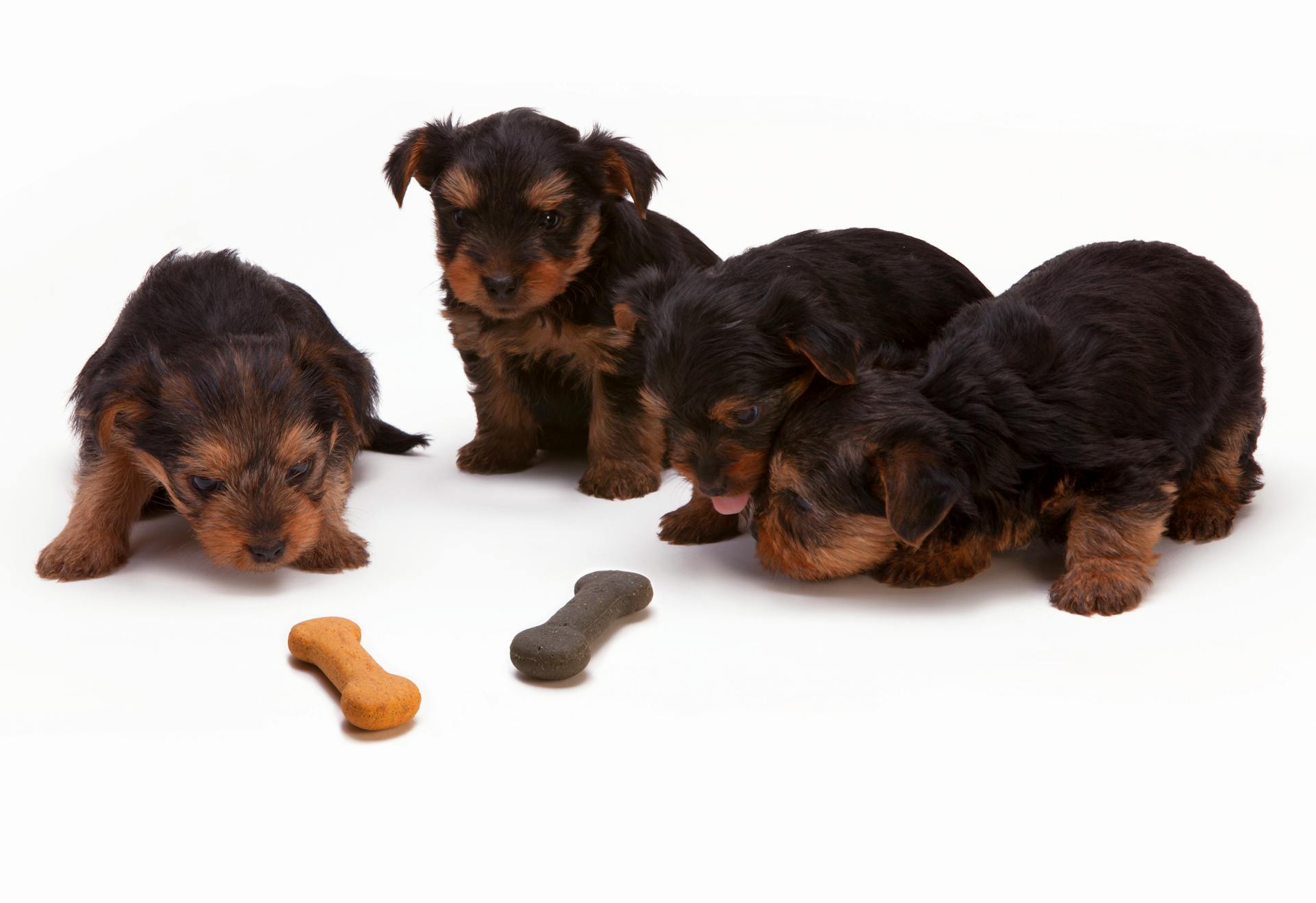
Creating a schedule for your puppy's potty breaks is crucial to successful housetraining. Puppies have tiny bladders and can only hold their urine for a certain number of hours corresponding to their age in months.
A good rule of thumb is to take your puppy out every hour or two, depending on their age. For example, a 6-month-old puppy can reasonably be expected to hold it for about 6 hours. You should also take your puppy out after meals, playtime, and naps.
To create a schedule, start by noting every time you take your puppy out to go to the bathroom, including any accidents in the house. This will help you identify patterns and figure out how often you should be taking them out. For instance, you might notice that your puppy always pees 30 minutes after drinking.
Here are some key times to include in your schedule:
- First thing in the morning and last thing at night
- After playing indoors
- After spending time in a crate or upon waking up from a nap
- After chewing a toy or bone, eating, or drinking
Remember, consistency is key, so stick to your schedule as much as possible. With a little patience and practice, you and your puppy will be on the right track in no time.
How Long Does It Take?
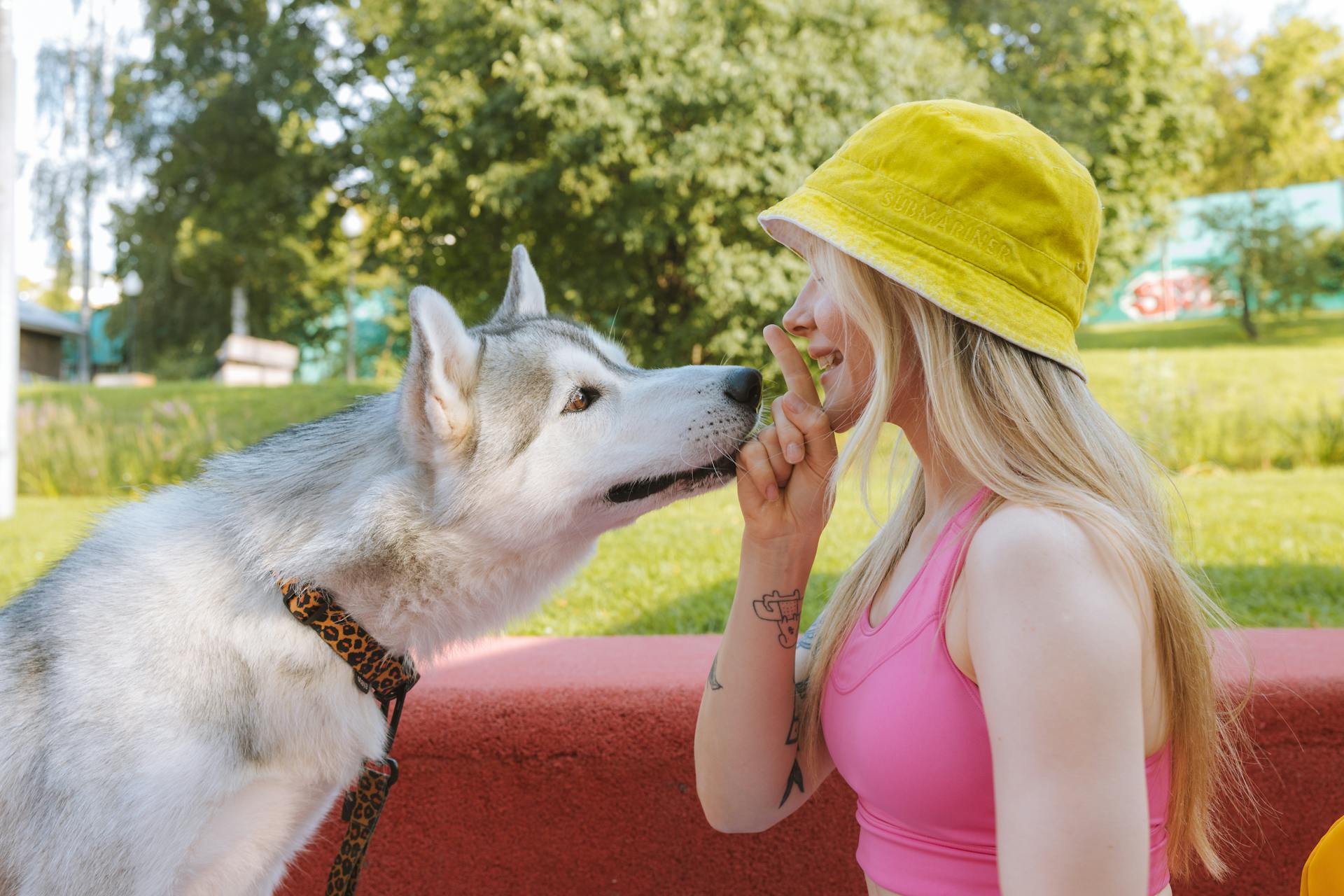
It can take a surprisingly short or long time to potty train a puppy, depending on factors like age and learning history. Some puppies pick it up in just a few days.
An 8-week-old puppy is very different developmentally than a 5-month-old puppy, which affects their learning pace.
With patience and persistence, most dogs can learn to use the potty, even if it takes months.
Some puppies have perfect manners after just a few days, while others may need more time and effort.
Frequently Asked Questions
How to potty train a puppy in 3 days?
Take your puppy out every hour and reward successful potty breaks with praise and treats to establish a routine and reinforce good behavior. Consistency and positive reinforcement are key to successful potty training in a short timeframe.
How long should you wait outside for your puppy to pee?
Wait 15 minutes for your puppy to do his business outside. If unsuccessful, return to crate for 15 minutes before trying again.
Sources
- bark potty from barkpotty.com (barkpotty.com)
- AKC Rx (akcpetrx.com)
- How to Potty Train a Puppy in 7 Days (chewy.com)
- @thepuppyacademy (instagram.com)
- How to Potty Train a Puppy | Four Paws (fourpaws.com)
Featured Images: pexels.com
